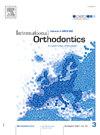Interdisciplinary management of a skeletal class II, hyperdivergent patient accompanied by multiple missing teeth and severe overeruption with orthodontic assisted space redistribution and implant restoration
IF 1.9
Q2 DENTISTRY, ORAL SURGERY & MEDICINE
引用次数: 0
Abstract
Long-term absence of posterior teeth often leads to significant overeruption of the antagonists, posing a substantial challenge for restorative treatment planning. This case report presents an interdisciplinary approach for a skeletal class II, hyperdivergent patient accompanied by missing maxillary second premolars (15,25), left maxillary second molar (27), mandibular first and second molars (36,37,46,47) and severe overeruption of maxillary first molars (16,17). The maxillary first molars were intruded using both buccal and palatal miniscrews while the existing maxillary spaces were closed. In the mandible, the existing spaces were strategically redistributed through the substitution of third molars for missing second molars, complemented by implant-supported restoration of the first molars. After 35 months of active treatment, well-aligned dentition, ideal intercuspation, and a notably improved facial profile were achieved, which remained stable during the 17 months follow-up. Overeruption resulting from long-standing absence of opposing teeth can be effectively managed through orthodontic intrusion with temporary anchorage devices. The strategic use of existing third molars for space redistribution offers a cost-effective, biologically conservative solution that preserves natural dentition.
1例伴有多颗缺牙和严重萌牙的II类骨超发散患者的跨学科治疗,正畸辅助间隙重新分配和种植体修复。
后牙长期缺失往往导致拮抗剂明显过度生长,对修复治疗计划提出了实质性的挑战。本病例报告介绍了一种跨学科的方法来治疗骨骼II类,伴有上颌第二前磨牙缺失(15,25),左侧上颌第二磨牙缺失(27),下颌第一和第二磨牙缺失(36,37,46,47)和上颌第一磨牙严重过度萌出(16,17)的超发散患者。上颌第一磨牙在上颌间隙闭合的同时,用颊和腭的微钉侵入第一磨牙。在下颌骨,通过第三磨牙替代缺失的第二磨牙,并辅以种植体修复第一磨牙,策略性地重新分配现有的空间。经过35个月的积极治疗,牙列排列良好,间断理想,面部轮廓明显改善,并在17个月的随访中保持稳定。由于对牙长期缺失导致的溢牙可以通过正畸侵入和临时支抗装置有效地处理。策略性地使用现有的第三磨牙进行空间重新分配提供了一种经济有效的、生物保守的解决方案,可以保护自然牙列。
本文章由计算机程序翻译,如有差异,请以英文原文为准。
求助全文
约1分钟内获得全文
求助全文
来源期刊

International Orthodontics
DENTISTRY, ORAL SURGERY & MEDICINE-
CiteScore
2.50
自引率
13.30%
发文量
71
审稿时长
26 days
期刊介绍:
Une revue de référence dans le domaine de orthodontie et des disciplines frontières Your reference in dentofacial orthopedics International Orthodontics adresse aux orthodontistes, aux dentistes, aux stomatologistes, aux chirurgiens maxillo-faciaux et aux plasticiens de la face, ainsi quà leurs assistant(e)s. International Orthodontics is addressed to orthodontists, dentists, stomatologists, maxillofacial surgeons and facial plastic surgeons, as well as their assistants.
 求助内容:
求助内容: 应助结果提醒方式:
应助结果提醒方式:


